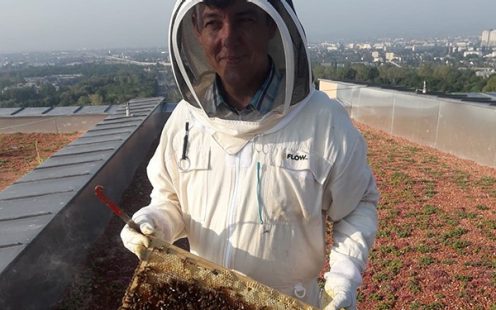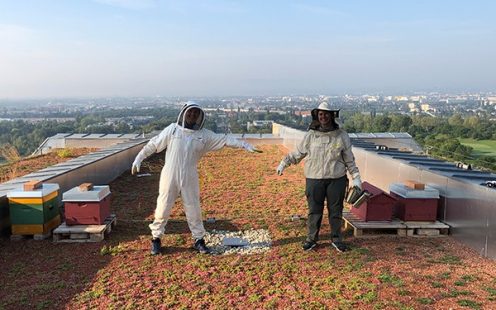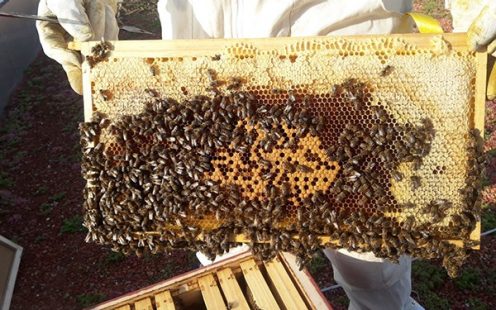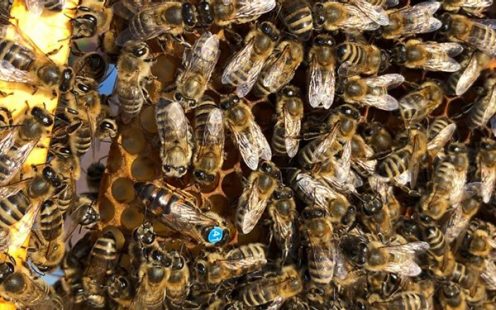WAGGLE DANCE: THIS IS HOW WE ARE PROMOTING BIODIVERSITY
Oct 13, 2020 | 4 min read
There's no missing the humming and buzzing on the roof of our corporate headquarters in Vienna's Biotope City: Honeybees are preparing to venture out on their daily foraging flights. With the settlement of bee colonies we are promoting biological diversity in the Wienerberg nature preserve and taking responsibility for nature and society.
Life on the roof of our office building
A new habitat has been created for about 80,000 honeybees at Pipelife's headquarters, the Wienerberger House, in Biotope City in the south of Vienna. Four beehives have been set up on the flat roof of the sustainable brick building, and more will follow next year. For us this is a special project: We do not only share our roof with them, but they also collect pollen where our mother company Wienerberger has its origin. 200 years ago, the first clay pit was created on Wienerberg. A nature preserve that now boasts rich fauna and flora grew around this clay pit when it was flooded.
Biodiversity is one of the pillars of our Sustainability Strategy 2020+, in addition to the circular economy and decarbonization. Thanks to the headquarters' proximity to green spaces, the bees are surrounded by an ideal environment. As soon as they venture out from the rooftop, they can start pollinating plants.
Hobby beekeepers set the ball rolling
The project has been implemented by Kathrin Hischenhuber, Assistant to the CFO at Pipelife, together with David Graham, Environmental, Health and Safety Manager at Pipelife. Ms. Hischenhuber, who holds a degree in zoology and is a passionate beekeeper, brought her passion to work: "David Graham and I are beekeepers in our spare time. Then we thought: How about we set up beehives on the roof of Wienerberger's group headquarters? We were delighted that out proposal was met with such positive response."
With this project, we are strengthening the domestic stock of bees and promoting plant and animal diversity in the preserve. In mid-September 4 hives were brought to the roof of the company's headquarters. Keeping bees on a building's roof is not uncommon in Vienna: On top of the City Hall, the State Opera and various hotels you can find large populations of these black-and-brown insects. All in all, there are around 5,000 beehives in Vienna.
Honeybees are the most important pollinators
As an integral part of the ecosystem, the honey-producing worker bees make sure that nature and biological diversity are maintained. The majority of flowering plants all over the world depend on pollination by insects, 85 percent of which is done by honeybees who pollinate around 170,000 different plant species. In doing so, they make a significant contribution to maintaining valuable habitats for plants and animals alike.
In contrast to the solitary wild bee, the honeybee lives together with other bees in an organized beehive, where it also spends the winter. The four bee colonies for the Wienerberger project come from one nucleus and the swarms from three colonies of a beekeeper. From June to mid-September 2020 the honeybees were located on the roof of the Federal Educational Institute for the Blind in Vienna. The bees were then put in boxes, loaded into two big cars and transported to their destination with great care.
Busy worker bees safeguard animal and plant diversity
Honeybees play a vital role in maintaining biodiversity in the nature preserve. On each flight a bee collects both pollen and nectar from several flowers. The nectar it collects is stored in its honey stomach, or crop, which it delivers when it returns to the hive. "This is how plants are pollinated and the nectar is collected for honey. To collect one kilo of honey, a bee would have to fly around the world four times," explains Hischenhuber.
Honeybees also dance to communicate with other bees. This waggle dance signals the location of valuable resources to their nestmates and recruits additional foragers to those resources. "Honeybees are extremely efficient in terms of collection output. Over its lifetime, one bee produces one teaspoon of honey on average," confirms her colleague David Graham. "Depending on how much honey is left in the end, the nestmates may even enjoy a free sample."
Bee colonies forage to various flowering plants that depend on them as pollinators: For fertilization, the pollen has to be transferred to the female reproductive organ of a flower, the pistil. When this happens, fertilization is possible, and a fruit, carrying seeds, can develop. This is how various plant species will continue to flourish in the Wienerberg recreational area.
The Wienerberg nature preserve
Following an urban planning competition, the recreational area Wienerberg in the 10th district of Vienna was developed in the 1980s. As a significant urban ecological biotope, the area features rich flora and fauna and is home to numerous animal and plant species, some of which are even on the red list of threatened species.
A characteristic feature of the nature preserve are the dry grasslands in the southeastern part of the grounds, which were declared a nature landmark in 1976. The Wienerberg pond is home to the largest reed reserves in the south of Vienna. The reed beds are an excellent breeding ground for singing birds such as the great reed warbler or the reed bunting. Birds from other habitats also come here in wintertime looking for food.
More beehives to come
The expansion of the bee-project is already in the pipeline: In spring 2021 two more beehives will be set up on the roof of Wienerberger's headquarters. This is one of our many large and small projects we, as part of the Wienerberger Group, are pursuing to help promote biodiversity.



